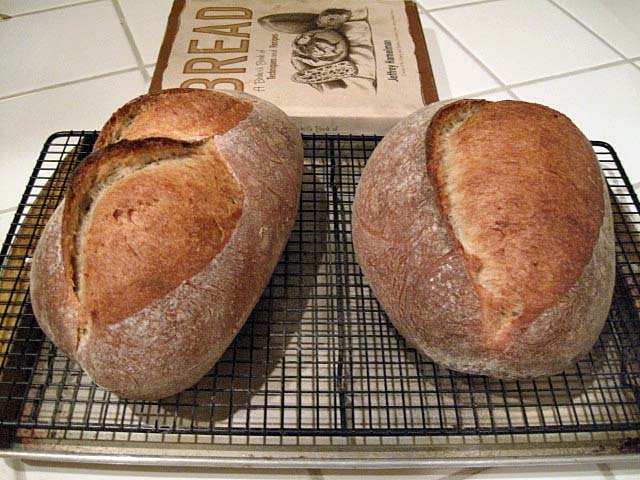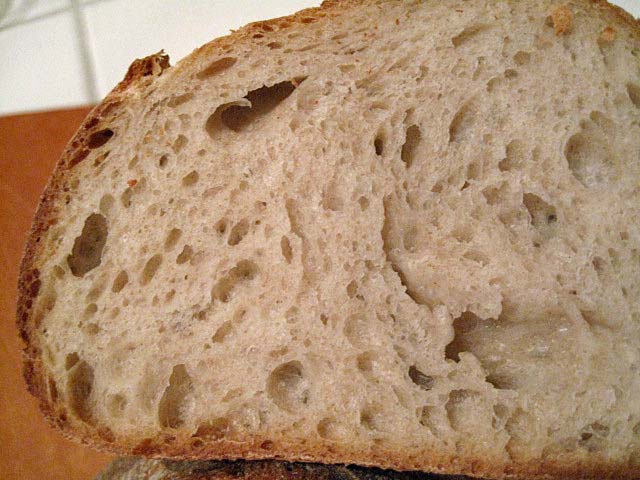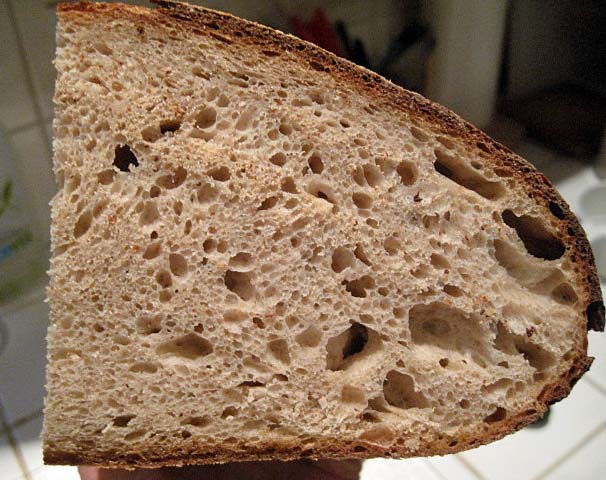I haven't baked anything but some of my personal "comfort food" breads for the past few weeks. These are just good almost any way - plain, with butter, toasted with almond butter and apricot preserves, French toast, as garlic bread, for panini ....

Hamelman's Pain au Levain

Hamelman's Pain au Levain crumb

SFBI Miche (made with half AP flour and half CM Organic Type 85)

SFBI Miche profile

SFBI Miche crumb
We have been enjoying them all week.
David
- dmsnyder's Blog
- Log in or register to post comments
Lovely, David!
I Always admired your mastery over scoring breads..
The bread toppings you mentioned above sound very yummy!
David
David, There are those lovely clean cuts again. I think I've finally diagnosed my snagging score openings to uneven air flow in the oven. So the top of the dough doesn't get as hot as the rest, and when the middle does start to open, the crust is already starting to form. In the case you were helping me with, my steam pan was actually blocking a vent. Do you do some sort of top treatment of your breads? I.e., stone on top? I got a new and much better sieve and just made more "high-ex" flour. Mixed with KAAP. Not bad at all. Now I will have to try the SFBI miche again. Your breads are beautiful and comforting. The miche looks perfect. -Varda
Hmmmm .... I wouldn't have expected un-even air flow as a cause, but maybe so.
I have a really super reliable oven with very even heat distribution. Nothing special or fancy. It just happens to be. It's a KitchenAid convection oven.
I have a 14 x 16 inch baking stone on the middle shelf pushed most of the way to the left and my skillet with lava rocks on the bottom shelf, placed all the way to the right. While steaming, I use a conventional bake setting. There is less air circulation, but I think the oven retains the steam better. Then I switch to convection bake for the last part to dry the crust.
I use this setup now for almost all lean hearth breads. My SJSD still gets the raggety edged ears. I think it's something about the higher-hydration dough.
Looking forward to your next miche!
David
I brought in an expert debugger to diagnose (my husband.) The loaf was expanding faster at the ends than in the middle. By the time the middle sprung up the crust was aleady partially formed which led to the snag. He surmised that with the vent being partially blocked there was a cold spot on top which eventually equalized but too late for even opening. I have since changed my steam pan set up to at least make sure the vent isn't blocked, and I have better results but not quite clean enough. I remember reading somewhere about someone putting a stone over the loaf (as well as under) but I guess that wasn't you. I center everything, so I am interested that you have stone to one side, steam to the other. Curious why? Do you have space between the oven wall and the stone so the air can circulate? Whatever you are doing obviously works. -Varda
Yes. I leave about 2 inches of rack space open to the left of the baking stone. I place the skilet all the way to the right to allow the steam to rise around the stone, at least that's my theory. Being right handed, it also makes it a little easier to put the perforated pie tin with ice cubes on top of the lava rocks.
Oh! One other recent change in my steaming routine: I used to load the bread, then put the pie tin on the lava rocks. Recently, I've been putting the pie tin on before loading the bread. All this is done within about 10 seconds, but I figure I want the oven steamy as soon as possible after the loaves go in. In the world of commercial, steam injected deck ovens, the oven is given a shot of steam before loading and another right after loading. At least that's my impression.
When I used to use Reinhart's steaming method of spritzing the oven with water, I would spritz before loading and again 3 times at 30-60 second intervals after loading.
Tweaking methods continue, but, as you say, my current method works for me.
David
bake bread 50% as well as you do David. Your bread is just beautiful and it must taste great - and now I have a camera to do my atempts at it 50% justice too :-)
Nice weekend bread bake !
David
Busy weekend David, and wonderful looking breads. The flavors and textures have to be indescribably grand. Nice Pictures. - Ray
It wasn't that busy a weekend. A busy weekend is baking four different breads. Three is typical. Two is just loafing. ;-)
David
David, your breads are the most beautiful, and I will make a bet that the flavor is wonderful. I also suspect that the skills in shaping learned at the SFBI add to that beautiful bake. I just made Hamelman's pain au levain this past week, but I have been enclosing them in a Lodge combo cooker for the round one and a La Cloche for the batard. I also love a mix of seeds, which I seem to put on everything these days. Sorry I didn't take photos, but they got eaten up before I even thought of it. My favorite of Hamelman's, BTW, is the mixed starter bread with the white and rye starters. Nothing seems to come close for flavor.
I admire the ears you get on your loaves. I proof in the bottoms of both vessels and preheat the tops at 500, which has worked well enough. But your method with the stone and the lava rocks and pie tin/ice cubes sounds so inventive. I have done the spritzing routine, also with a pan of water preheated with the oven below, which gives a hit of steam. But the La Cloche has worked the best for me, the cast iron second best.
So now I'm dreaming of the SFBI classes. At my age (won't tell), I'm just wondering about being on my feet all day for a week. How did that work out for you?
Joy
Thanks for your kind words.
I did learn a ton in the SFBI workshops, and it was also just great fun. We were on our feet for more than an hour at a time only occasionally. The typical day had us moving back and forth between the classroom and the "lab" many times. I was the second oldest in the class for Artisan I and probably the oldest in Artisan II. Except for the lunch break, the class is fast-paced, and I found it energizing rather than tiring. I had plenty of energy left at the end of the day for going out for dinner. The hardest thing was getting up early in the morning. I'm not an early morning person.
The SFBI experience did teach me a lot about dough handling, including shaping. It was partly specific techniques, but, even more, a greater understanding of basic principles. After the workshops, I got a lot more out of reading bread books and watching videos. So, I'm better able to appreciate the finer points and incorporate them selectively and with an understanding of when and why to use one technique rather than another in particular situations.
As far as scoring goes, I think I learned the most from a careful reading of what Hamelman and Suas had to say about it, especially Suas. Their advice is rather brief but information dense. I quoted the pertinant text from Suas in the Scoring Tutorial I wrote for TFL.
I can't recommend the SFBI workshops too highly. You should also be aware that they are offering more weekend workshops, if you don't feel up to a 5-day one. I bet that, if you needed to, you could bring a stool into the lab to give your feet a break.
I bought a couple Lodge cast iron Dutch ovens when I got the Tartine Breads book, but I now seldom use them. I usually make the Tartine BCB as large bâtards. The Dutch ovens do work wonderfully well, though.
I have enjoyed all the Hamelman pain au levain versions. I agree that the mixed levain one is the most interesting in flavor. Hmmmm ... Maybe it's time to make that one again.
David
They certainly look their part, and would comfort me, too!
I'm baking lots of soda breads for St. Patrick' Day, and their crumb couldn't look more different.
Karin
David
Very fine "loafing" David, I have to say!
Best wishes
Andy
And this weekend .... so far ... I've only made some San Francisco Soudoughs. But I've also baked some chicken breast that will be a panini component for tomorrow night's dinner and a pot of French Onion Soup for another meal during the week. I might put up a poolish and a soaker for whole wheat bread to bake tomorrow.
Bread baking serves, among its several rewarding functions, as an effective method of keeping me from the work I'd rather avoid, a list of which sits on my desk. <sigh>
David
Hi David,
This quote sat on my wife's desk for some time around the time we got together, and I really like it:
"What you do instead of your work is your real work." -- Roger Ebert.
All good wishes
Andy
I was just coming back to edit my last reply to pose the question: "What does a professional baker like yourself do to procrastinate."
So, I suppose my "real work," at this time, is bread baking and calligraphy.
David
Those are some mighty fine loaves, David! Beautiful scoring and terrific crumbs. Your weekend round-ups are always a source of great inspiration!
Judging from your reply to Andy above, you've kept busy this weekend as well! Cooking is a labor of love.
David
That kind of procrastination is a virtue.
David
Much appreciation for your description of the two SFBI artisan classes and the suggestion re. weekend workshops. I will give them some serious consideration. At some point, one needs to move to the next level, and self-education may go just so far.
Love the quote re. "real work"! I think economics sometimes get in the way of clarity.
Thanks again! --Joy